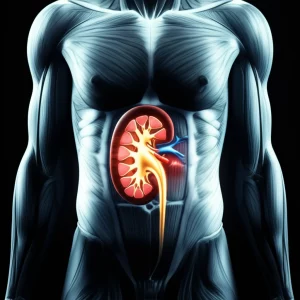Unpacking the Link: How Mild Thyroid Issues and Growth Factor Connect to Metabolic Risks in Obese Boys
Hey there! So, I was checking out some pretty interesting research lately, and it really got me thinking about something super important: the health of our kids, especially when it comes to weight. We all know childhood obesity has become a massive global issue over the past fifty years, right? It’s everywhere, and it brings a whole bunch of health worries with it.
One thing researchers have been looking into is the connection between obesity and something called subclinical hypothyroidism (SH). Now, don’t let the fancy name scare you. Basically, SH is when your thyroid-stimulating hormone (TSH) levels are a bit high, but your main thyroid hormone (FT4) is still in the normal range. Think of it as your thyroid gland getting a little extra nudge from the brain, even though it’s mostly keeping up.
In kids, they even break SH down further. There’s ‘Evident SH’ where TSH is quite high (10 mU/L or more), and then there’s ‘Mild SH’ (MSH), where TSH is just slightly above the normal limit, but still below 9.9 mU/L. This mild version is a bit of a puzzle, especially in obese kids. Does it really make things worse? Does it matter?
What This Study Set Out to Do
That’s where this particular study comes in. I found this paper that wanted to dig into MSH specifically in obese boys. They had a couple of big questions:
- Is there a relationship between MSH and something called Insulin-like Growth Factor-1 (IGF-1) in obese boys?
- Does having MSH make the cardiovascular risk factors linked to obesity even worse for these boys?
IGF-1 is pretty cool stuff. It’s a hormone that plays a key role in growth, you know, helping bones and tissues grow. Previous studies have hinted that IGF-1 levels might be lower in obese kids, and low IGF-1 has been tied to various metabolic problems like fatty liver, insulin resistance, and metabolic syndrome. Some research in adults with SH also found lower IGF-1, but the picture in kids, especially obese ones with MSH, wasn’t clear.
How They Looked Into It
So, here’s how they did it. They gathered data from 141 obese boys and compared them to 47 healthy boys who weren’t obese. The obese boys were all between 6 and 14 years old. They then split the obese boys into two groups based on their TSH levels: one group had MSH (47 boys), and the other didn’t (94 boys). They checked all sorts of things – height, weight, blood pressure, liver function, cholesterol, blood sugar, insulin, and, of course, thyroid hormones and IGF-1.
The Key Findings: MSH vs. Non-MSH Obese Boys
When they crunched the numbers, some pretty significant differences popped out when comparing the obese boys with MSH to the obese boys without MSH:
- The MSH group had significantly lower IGF-1 levels (specifically, the IGF-1 standard deviation score or SDS, which accounts for age).
- The MSH group had significantly higher BMI (again, using the BMI SDS).
- Metabolic markers were worse in the MSH group: they had higher triglycerides (TG) and higher gamma-glutamyl transferase (GGT) levels.
- The incidence of Non-Alcoholic Fatty Liver Disease (NAFLD) and Metabolic Syndrome (MS) was significantly higher in the MSH group compared to the non-MSH group.

Drilling Down: What’s Independently Linked to MSH?
This is where it gets really interesting. They used a fancy statistical method (multivariable logistic regression) to see which factors were *independently* associated with MSH, meaning they were linked even after accounting for other things like blood pressure, liver enzymes (ALT, GGT), and uric acid. And guess what? The results showed that:
- Lower IGF-1 SDS was strongly associated with MSH.
- Higher BMI SDS was also strongly associated with MSH.
This suggests that having a higher BMI makes MSH more likely, while having lower IGF-1 makes MSH more likely, and these links seem to be independent of some other metabolic issues they checked. They even called BMI SDS an “independent risk factor” for MSH and IGF-1 SDS a “protective factor” against MSH in these obese boys. Pretty cool, right?
The IGF-1 Connection: A Potential Biomarker?
The finding about IGF-1 is a big deal. They saw lower IGF-1 in the MSH group, found a negative correlation between TSH and IGF-1 (meaning as TSH goes up, IGF-1 tends to go down), and the regression analysis confirmed IGF-1 was an independent protective factor. This really supports the idea that IGF-1 is somehow tied into this picture.
Why might IGF-1 be lower? The study mentions a few possibilities, though the exact mechanism isn’t totally clear. It could be related to how thyroid issues affect growth hormone production (which influences IGF-1), or maybe leptin (a hormone linked to obesity) plays a role, or even chronic inflammation, which is common in obesity and can affect both thyroid hormones and IGF-1. There might even be other pathways involved that don’t directly involve growth hormone.
Since lower IGF-1 has been linked to metabolic problems like fatty liver and metabolic syndrome in other studies, these findings suggest that in obese boys with MSH, the lower IGF-1 might be contributing to those extra metabolic risks they observed. The researchers think IGF-1 could potentially be a useful marker to check in obese kids to see if they might be at higher risk for these metabolic issues, especially if they also have MSH.
Metabolic Fallout: Lipids, Liver, and Insulin
Beyond IGF-1, the study also looked closely at other metabolic parameters. They found that obese boys with MSH had higher triglycerides (a type of fat in the blood). While other cholesterol numbers weren’t statistically different between the MSH and non-MSH obese groups in this study, they did find correlations between TSH and total cholesterol and LDL-cholesterol (the “bad” cholesterol) even after accounting for BMI. This makes me think, and the study suggests, that even if the differences aren’t huge *right now*, these kids might be at risk for developing more significant lipid problems over time, which is something to keep an eye on.
Fatty liver (NAFLD) was also more common in the MSH group, which lines up with some previous research. And they found higher levels of GGT, a liver enzyme, in the MSH group. Interestingly, the correlation between TSH and GGT seemed to disappear when they adjusted for BMI, which hints that body weight might be a key reason for that connection. It’s like the obesity itself is driving both the higher TSH (mildly) and the higher GGT, rather than the MSH directly causing the GGT increase independent of weight.
What about insulin resistance? This one’s a bit tricky. In this study, they didn’t find a significant difference in insulin levels or insulin resistance (measured by HOMA-IR) between the MSH and non-MSH obese groups. This actually contrasts with some other studies that *did* find a link between TSH and insulin resistance in obese kids. The researchers point out that this could be due to differences in the kids studied (age, puberty stage, ethnicity, how obese they were) or even how insulin resistance was measured. It just goes to show that these things are complex and sometimes studies have different results, which means we need more research to get a clearer picture.

What We Don’t Know Yet (And What’s Next)
Like any good study, this one has its limits. Since it was a snapshot in time (cross-sectional), it can show associations but not necessarily cause and effect. We can say MSH and low IGF-1 are linked, but we can’t say for sure that one *causes* the other based on this study alone. Also, they only looked at boys, so we don’t know if the same relationships hold true for obese girls. The control group was also a bit small, which is a common challenge in pediatric research.
Another big question left unanswered is whether treating the MSH with thyroid hormone medication (levothyroxine) would actually improve the IGF-1 levels or the metabolic issues they saw. That would be a really important thing to figure out in future studies.

So, What’s the Takeaway?
Putting it all together, this study gives us some strong evidence that in obese boys, mild subclinical hypothyroidism (MSH) is tied to both lower IGF-1 levels and higher BMI. And it seems like having MSH on top of obesity is associated with slightly worse metabolic markers like higher triglycerides and GGT, and a higher chance of having fatty liver and metabolic syndrome.
For doctors and parents, this means that if an obese boy has MSH, it might be extra important to keep an eye on things like their BMI, IGF-1 levels, and other metabolic indicators. While we still need more research to understand exactly *why* all these things are connected and whether treating MSH would help, these findings highlight that MSH isn’t just a random lab value in obese boys; it might be a signal that they’re at a slightly higher metabolic risk.
It definitely makes a case for targeted screening and maybe even thinking about early interventions to help manage weight and metabolic health in this group. And figuring out the exact biological pathways linking IGF-1 and MSH in obesity? That’s a key piece of the puzzle for future research!
Source: Springer







